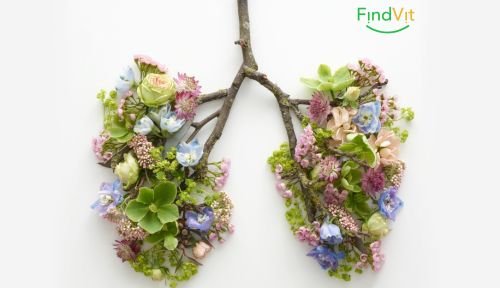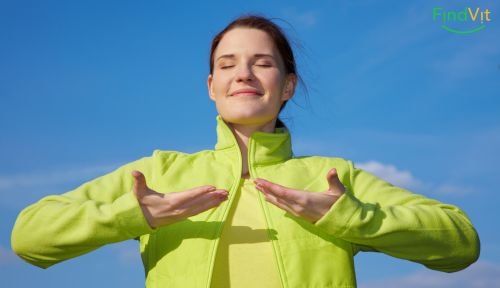Breathing is an automatic function that sustains life, but its ability to improve well-being is often underestimated. Proper use of breathing techniques can transform simple survival into thriving health, increasing oxygen levels in the blood, reducing stress, and raising energy levels.1
This aspect of health care delves into the complex balance of mind and body, showing how controlled breathing can serve as a powerful tool for self-regulation and well-being. Despite its simplicity, the art of breathing is the key to unlocking great physiological and psychological benefits.

This article will introduce readers to a variety of breathing techniques for a variety of purposes, from reducing stress and improving focus to energizing the body and increasing lung capacity through the breathing system.
Techniques such as diaphragmatic breathing, Buteiko and 4-7-8 breathing help not only to manage the body's response to stress, but also to optimize the consumption of oxygen, which is very important for the body's functions. In addition, insights into the holistic impact of nutrition on respiratory health will be provided and how a synergistic approach can enhance the benefits of mindful breathing.
Whether you want to relax, recharge, or take better control of your emotional and physical state, this guide contains valuable strategies for anyone who wants to use the power of the breath to improve their health and well-being.

Interesting facts about breathing and the respiratory system
The respiratory system is a complex network that not only facilitates respiration, but also involves complex processes that vary greatly from species to species. In mammals and reptiles, gas exchange takes place in millions of tiny air sacs called alveoli. These microscopic structures are able to saturate the blood with oxygen. Alveoli respond to the external environment through the airways, including the trachea and bronchi, and birds have bronchioles called parabronchi.
Interestingly, most fish and other aquatic animals have gills, often external organs, that filter oxygen-rich water. Gills can take up water in a number of ways, and gas exchange occurs when thin or flat gill filaments allow water to envelop a large surface area of vascular tissue.
Other animals, such as insects, have much simpler respiratory systems, while in the case of amphibians, the skin plays an important role in gas exchange. Plants also have respiratory systems, which can have a gas exchange cycle opposite to that of animals, and anatomical features such as stomata in different parts of the plant.
One of the main tasks of the respiratory system is to properly balance the partial pressure in the lung alveoli and capillary blood. This process occurs due to diffusion through the alveolar walls, which are collectively known as the blood-air barrier. The amount of air in the alveoli is fairly constant, about 2.5-3.0 liters, and it completely envelops the capillary blood in the alveoli. The partial pressure of oxygen in the blood leaving the alveolar capillaries and ultimately distributed throughout the body is about 13-14 kPa (100 mmHg), and the partial pressure of carbon dioxide is about 5.3 kPa (40 mmHg).
Air density decreases rapidly with increasing altitude, and at an altitude of 5,500 meters above sea level, it is approximately halved. Since the composition of atmospheric air is almost constant below 80 km altitude, the oxygen concentration in the air decreases at the same rate as the air pressure at altitude above sea level.
In addition, the airway epithelium can secrete various molecules that help protect the lungs. These are secretory immunoglobulins (IgA), collectins, defensins (cationic proteins) and other peptides and proteases, reactive oxygen species and reactive nitrogen species. Pulmonary vessels contain a fibrinolytic system that dissolves clots that may have entered the pulmonary circulation due to embolism. They also secrete various substances into the systemic arterial blood and remove others from the systemic venous blood, which reaches them via the pulmonary artery.
The lungs can secrete hormones: the physiologically inactive decapeptide angiotensin I is converted in the pulmonary circulation to the aldosterone-releasing octapeptide angiotensin II. This reaction also occurs in other tissues, but it is particularly pronounced in the lungs.

Deep breathing for relaxation
Deep breathing, also called diaphragmatic breathing, is a basic relaxation and stress reduction practice. When the diaphragm is activated, the parasympathetic nervous system is activated, which promotes calmness and relaxation.
How to practice breathing
To practice deep breathing effectively, you can start from a comfortable position - sitting, standing or lying down. The most important thing is to breathe deeply from the belly, inhaling to push the belly out, and exhaling to allow it to come back. This can be done by placing your hand on your stomach to feel it rise and fall. A simple technique is to inhale slowly through the nose for about four seconds, hold the breath for seven seconds, and exhale slowly through the mouth for eight seconds. This method, often called the 4-7-8 technique, is useful for calming the mind before bed or during times of high stress.
Mental and physical benefits
The mental and physical benefits of deep breathing are enormous. Psychologically, it helps reduce stress and anxiety by reducing cortisol, the body's stress hormone. It also helps you focus and concentrate better by stabilizing your heart rate and promoting a state of present awareness. Physically, deep breathing improves oxygen metabolism, which increases energy levels and supports cellular functions. Regular breathing can improve cardiovascular health by lowering blood pressure and heart rate, thereby reducing the risk of heart-related diseases. In addition, deep breathing can help manage pain and promote better sleep by relaxing the muscles and calming the mind.
Incorporating deep breathing into your daily routine can significantly improve your mental and physical well-being, making it a powerful tool for overall health and well-being.

What is the Buteyko Breathing Technique?
20th century Developed in the 1950s by Ukrainian physiologist Konstantin Buteik, the Buteik breathing technique emphasizes the important role of carbon dioxide in respiratory and general health. She challenges conventional wisdom about hyperventilation and its effects, arguing that many respiratory problems are caused by breathing too much and thereby depleting carbon dioxide.
Origin and history
Dr. Buteyko first noticed the connection between rapid, shallow breathing and poor health while studying medicine. This observation led to the development of Buteika's method, which focuses on slowing the rate of breathing to increase carbon dioxide and improve tissue oxygenation. This technique can help people suffering from asthma, allergies, anxiety and other health problems.
How the Buteiko method works
At its core, Buteik's method consists of exercises that reduce the rate or volume of breathing to correct what is considered chronic overbreathing. The techniques used are: breathing through the nose, which is essential for filtering and warming the air, and conscious breath control to induce a state of "air hunger", which is believed to re-regulate the respiratory system.
How to breathe
1. Relaxation and preparation
- Find a quiet place: Choose a quiet and peaceful corner of the room where you can concentrate and not be disturbed.
- Sit comfortably: Sit up straight but comfortably so that your back is straight and your hands rest freely on your knees.
2. Natural breathing
- Watch your breathing: Start observing your natural breathing. Pay attention to how you breathe - through your nose or mouth, fast or slow.
- Breathe through your nose: Make sure you breathe only through your nose. Breathing through the nose helps regulate airflow and maintain proper blood carbon dioxide levels.
3. Easy breathing
- Inhale and exhale gently: Inhale gently and slowly through your nose. Your breathing should be light and quiet, almost imperceptible.
- Reduce the depth of breathing: Try to breathe more shallowly than usual. Reducing the depth of breathing increases the amount of carbon dioxide in the blood, which helps maintain proper acid-base balance.
4. Retention after exhalation
- Exhale and hold your breath: After a slow exhalation, close your nose and hold your breath. Keep your mouth closed and do not breathe through it.
- Count the seconds: Hold your breath as long as possible, but only for as long as you feel comfortable. Start with a few seconds and gradually increase the time.
5. Recovery and control
- Release your nose and breathe gently: When you feel the need to inhale, release your nose and start breathing gently through it again.
- Breath control: Repeat this process several times. Over time, you should notice that your breathing becomes easier and more controlled.
6. Practicing daily
- Regular practice: Practice the Buteyko breathing technique every day, at least for a few minutes in the morning and in the evening.
- Follow the progress: Track your progress over time. You should notice improved breath control, reduced stress, and a general sense of well-being.
Buteyko's method will benefit
Practitioners of the Buteik method report improvements in conditions such as asthma, anxiety and sleep apnea. By maintaining nasal breathing and controlling the initial phases of rapid breathing, individuals are said to be able to prevent exacerbations of breathing problems and improve overall cardiovascular health. This method is recognized for its ability to treat various health problems by fundamentally changing breathing habits.

4-7-8 Breathing Technique
The most important steps
The 4-7-8 breathing technique is a method developed by Dr. Andrew Weil based on a specific pattern of breath control. Here's how to do it:
- Exhale completely through your mouth, making a whistling sound.
- Close your mouth and breathe in slowly through your nose, mentally counting to four.
- Hold your breath until you count to seven.
- Exhale completely through your mouth, making a “chuuuu” sound for a count of eight.
- This is one breathing cycle. Start with four such cycles and gradually increase to eight.
Benefits are received
This technique works as a natural sedative for the nervous system, helping to quickly reduce stress and anxiety. It enhances control of breath holding, improves lung efficiency and oxygen consumption. Regular practice can improve concentration and emotional stability, especially useful in high-stress environments.
When is it best to use?
The 4-7-8 breathing technique is most effective when applied during times of increased stress or before sleep. It can be practiced in any position, but beginners are recommended to sit with a straight back and feet on the ground. For those who struggle with sleep disorders, doing the technique before bed can promote faster and deeper sleep.
Diaphragmatic breathing
Diaphragmatic breathing, often referred to as diaphragmatic breathing, is a technique that helps you use the diaphragm, the main breathing muscle, more effectively. With each inhalation, the diaphragm descends, inflating the abdomen, and with each exhalation, it rises, inflating the chest. This method increases lung capacity and increases oxygen consumption, thus providing health benefits.
Sequence and steps
- Start by lying on your back or sitting comfortably with one hand on your stomach.
- Inhale slowly through your nose, allowing your belly to rise as your diaphragm contracts and pulls you down.
- Hold your breath for a moment.
- Exhale slowly through your mouth, imagining that you are gently blowing out a candle, while the abdomen contracts and the diaphragm rises.
- Repeat this cycle, gradually increasing the duration of each phase as comfortably as possible.
Main benefits
Diaphragmatic breathing is a key factor in improving blood oxygenation, which improves cardiovascular function, stimulates the lungs, and reduces the risk of shortness of breath. Regular breathing can also reduce stress and anxiety by stimulating the release of endorphins, the body's natural pain relievers. Massaging the abdominal cavity during breathing movements supports the functions of internal organs, possibly aids digestion and reduces constipation.

Square breathing
Tips on how to do it
Square breathing, also known as box breathing, involves a simple but effective breathing pattern that can be practiced by anyone who wants to manage stress and improve breathing efficiency. To start, find a quiet place where you can sit comfortably. Follow these steps:
- Breathe in slowly through your nose for four seconds to completely fill your lungs with air.
- Hold your breath for four seconds while maintaining a calm and relaxed posture.
- Exhale smoothly through your mouth for four seconds, expelling all the air from your lungs.
- Hold your breath again for four seconds before starting the next cycle.
Tangible benefits
This breathing technique activates the parasympathetic nervous system, promotes relaxation and aids digestion. It is especially useful in reducing emotional swings, anxiety, panic attacks and even depression symptoms. The controlled pace of breathing through the nose also helps to warm, humidify and filter the air, protecting against respiratory infections.
When is it best to use?
Box breathing is very effective when you need to quickly relieve tension, especially before a meal to stimulate digestion or during stressful situations to regain control of your emotions. It is also ideal before important presentations or exams, when a calm, focused state is beneficial. Emphasizing long exhalations during this practice can naturally calm the mind in moments of frustration or anger.
Alternate Nostril Breathing (Nadi Shodhana)
Alternate Nostril Breathing, also known as Nadi Shodhana or Alternate Nostril Breathing, is a traditional practice that helps balance the body and calm the mind. It is particularly effective in harmonizing both hemispheres of the brain and promoting mental clarity.
Stages of performance
- Sit in a comfortable position with a straight spine.
- Place the thumb of the right hand on the right nostril and the ring finger on the left nostril.
- Close the right nostril with your thumb and inhale slowly through the left nostril.
- Close the left nostril with the ring finger and slowly exhale through the right nostril.
- Keeping the left nostril closed, inhale through the right nostril.
- Close the right nostril with your thumb and exhale through the left nostril.
- This completes one cycle of Nadi Shodhana.
Related benefits
Practicing Nadi Shodhana can strengthen breathing and increase oxygenation to the brain, reducing stress and increasing energy levels. It is known to lower the heart rate and promote relaxation, making it beneficial for those suffering from anxiety or stress-related disorders. Regular practice helps detoxify the lungs and balance the body's energy channels, resulting in improved overall health.
When to use
Nadi Shodhana is best performed during times of emotional stress or before engaging in activities that require mental stamina and concentration. It is also effective as a preparatory breathing exercise before meditation or yoga classes, helping to calm the mind and body and achieve a state of greater awareness and peace.

„Lion's breath for energy
"Lion's Breath" is a breathing exercise that gives courage and self-confidence, especially useful for children. This technique is not only energizing, but also helps manage emotions such as anxiety and stress, which is why it is loved by many.
Steps to proper breathing
To effectively practice the Lion Breath:
- Find a comfortable sitting position in which the spine is straight.
- Take a deep breath through your nose, filling your lungs completely.
- Open your mouth wide, stick your tongue down towards your chin and exhale forcefully, making the sound "ha" from deep in your stomach.
- Repeat this process several times to feel energized and clear your mind.
Benefits
Lion's Breath is famous for its direct effect on the nervous system, activating the parasympathetic state, which promotes relaxation and digestion. Regular practice can significantly modulate the body's response to stress, reduce symptoms of panic attacks and even depression. It also helps clear the airways, promoting a healthy, strong exhalation.
When to use
This breathing technique is especially effective when you need a quick burst of energy or when you want to restore mental clarity before engaging in an activity that requires attention. It is also useful before meals to stimulate digestion or during times of stress to restore emotional balance.

Breathing technique to improve concentration
How to practice
One of the effective methods of improving breathing concentration is a structured pattern. Start exhaling gently through your mouth without consciously inhaling first, as if you were taking a gentle breath. Then inhale through your nose to the count of four. Hold your breath for seven seconds and slowly exhale to the count of eight, making a soft sound. Repeat this four times at first, gradually increasing the number to eight repetitions. Another way is to sit up straight, close your eyes and breathe deeply without opening your mouth, humming the soft sound of "Om". After a few repetitions, cover your ears with your index fingers, inhale, and as you exhale, press and release your ears intermittently to feel the vibrating sound. Repeat this several times.
Benefits in daily activities
These breathing techniques are very useful in everyday activities. They are known to quickly lower your breathing and heart rate, making them great for calming the mind and preparing the body for sleep. Their simplicity makes them widely available and easily incorporated into daily activities. Regular practice can help maintain a natural breathing rhythm, which is especially useful for managing stress and increasing concentration when performing complex tasks. By developing a conscious approach to breathing, people can achieve a more relaxed yet alert state, ideal for both professional and personal commitments.

Three-part breathing
Three-Part Breathing, often integrated into yoga practice, is a comprehensive breathing technique that strengthens physical health, the nervous system, and promotes spiritual growth. For optimal results, this method is best combined with traditional yoga exercises, meditation and an ascetic lifestyle.
How to breathe correctly
- Slow Breathing: Begin by breathing in very slowly, fully expanding your lungs.
- Hold your breath: After inhaling, hold your breath for a moment to absorb as much oxygen as possible.
- Exhale slowly: Begin exhaling slowly and in a controlled manner, letting all the air out of your lungs.
- Pause: After exhaling, pause briefly to complete one cycle.
- This breathing pattern consists of three parts: the diaphragm, thoracic and clavicle areas, which facilitate deep and thorough oxygenation.
Best benefits
Regular practice of Three-Part Breathing has many benefits:
Better physical health: improves overall respiratory function and increases endurance.
Nervous System Strength: Helps calm the mind and reduce stress by regulating the nervous system.
Spiritual growth: Promotes a deeper connection with your inner self, helps you develop spiritually.
This technique is especially useful in preparation for meditation, as it helps to achieve a state of deep relaxation and mental clarity. Regular practice harmonizes the active elements of human existence—creation, destruction, and preservation—and brings harmony to body and mind.
Nutrients are important for respiration
Nutrition has a big impact on the efficiency of the respiratory system and overall health - more than you might imagine. Some foods, such as milk and eggs, can trigger asthma episodes, while others, such as onions and garlic, protects against bronchitis. Fruits and vegetables rich in beta-carotene help protect against lung cancer. Research in England and Wales shows that children who eat two or more pieces of fruit a day have better breathing and less wheezing. In contrast, those who consume processed meats such as ham and sausages often experience breathing difficulties.
Some foods can relieve a cough by eliminating its causes, while others can make it worse. To improve the health of the respiratory tract, it is advised to consume more onions, honey, lemons and vitamins A and C. Conversely, reducing or avoiding salt and dairy products is recommended. Various foods have healing properties that are essential for bronchitis sufferers. Mucolytics, such as onions and radishes, help thin and clear mucus, while sedatives, such as dates, figs, and okra, reduce inflammation in the airways. Antibiotics and antiseptics such as garlic and propolis fight bacteria and viruses that cause bronchitis.
Lean beef is good for maintaining a strong immune system, as it is rich in zinc, selenium and vitamin B6, which are very important for the immune system. Chicken broth, which has a mild anti-inflammatory effect, can also reduce the chance of respiratory infections. A bowl of chicken broth can be healthier than other hot liquids because of its protein and healthy ingredients like garlic and onions.
FAQs (Frequently Asked Questions) about Breathing Technician:
What are breathing techniques?
Breathing techniques are special exercises aimed at improving respiratory function, reducing stress, improving sleep quality, and strengthening general health. These techniques are often used in yoga, meditation, and other wellness practices.
Why are breathing techniques important?
Breathing is an essential function of our lives, but many people do not realize how much the right breathing can affect health. Properly performed breathing exercises can help reduce anxiety, improve heart function, boost the immune system, and help with insomnia.
What are the most popular breathing techniques?
The most popular breathing techniques are:
Diaphragmatic breathing: Using deep inhalations and exhalations to maximize the use of the diaphragm.
4-7-8 technique: Inhale for four seconds, hold for seven seconds and exhale for eight seconds.
Breathing box: Four equal phases (inhale, hold, exhale, hold) each lasting the same amount of time (eg four seconds).
How to start practicing breathing techniques?
You can start practicing breathing techniques anytime, anywhere. The most important thing is to find a quiet place where you can concentrate. Start with simple exercises, such as deep diaphragmatic breathing, and gradually try more complex techniques. Tip: Use meditation or breathing exercise apps that can help you track time and pace.
Can breathing techniques help reduce stress?
Yes, breathing techniques are one of the most effective ways to reduce stress. They help slow the heart rate, lower blood pressure and promote relaxation. Regular practice of breathing exercises can help achieve a long-term stress-relieving effect.
How do breathing techniques affect sleep?
Breathing techniques help to calm down and prepare the body for sleep. Certain techniques, such as the 4-7-8, are designed specifically to improve sleep quality. They help reduce anxiety and stress, which often interfere with sleep.
Conclusions
As we explore a variety of breathing techniques, from calming deep diaphragmatic breathing to the balanced rhythm of Nadi Shodhana, it becomes clear how important breath control is to maintaining and improving our mental and physical well-being. Every technique for reducing stress, improving concentration, or increasing energy emphasizes that conscious breathing can have a profound effect on our bodies. The importance of combining these practices with a well-rounded diet cannot be overlooked, as it enhances the benefits of each breath and demonstrates a holistic approach to health that nurtures both body and mind.
In conclusion, the art of breathing, deeply rooted in both science and tradition, is a powerful toolkit for dealing with the stresses of modern life. By adopting these practices and incorporating them into their daily routine, people can improve their health, focus, and experience inner peace. The journey through these techniques does not end with a better understanding of the respiratory system, but becomes a holistic lifestyle choice that promotes overall well-being and balance. With regular practice and proper attention to nutritional needs, the path to greater vitality and peace is within reach.











